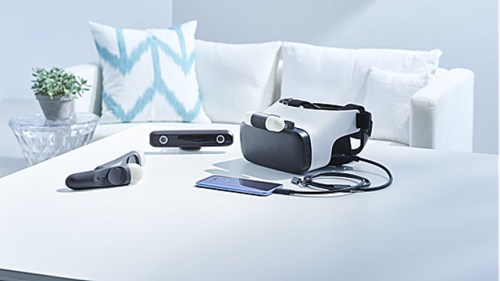
But it is a step above something like the Samsung Gear, which uses your smartphone as both a source of content and as a display. In short, the HTC Link is a compromise. While it connects with your smartphone, it features its own display, perhaps heralding a new phase in VR headsets.
As originally reported by Japanese site Mogura VR, the Link will work with HTC’s newest smartphone, the HTC U11. However, it will employ an outside-in tracking system, thereby supporting its full six degrees of freedom (6DOF) tracking. This makes it the first mobile headset to offer such a feature. But alas, for now, the Link will only be available in Japan, and HTC told UploadVR that the kit isn’t currently slated to go on sale anywhere else.
There’s not a ton known about the HTC Link quite yet, but it doesn’t look like the headset will use HTC Vive’s lighthouse stations. Instead, the headset and its two controllers seem to have lights on them that are potentially trackable using an external sensor. Released specs note that the Link features two 3.6 inch 1,080 x 1,200 LCD panels with a 90Hz refresh rate. And it’ll weigh in at a manageable 554g.
The Link announcement comes just a week after Google announced its plans to create new standalone VR headsets alongside HTC. So if you’re a VR enthusiast, keep your ear to the ground. It looks like we could be expecting a lot more in the space in the near future.
Editors' Recommendations
- Quest Pro 2: What we know about Meta’s next premium VR headset
- Meta Quest 4: Here’s what we want from the next big VR headset
- Watch Apple’s new ‘Get Ready’ ad for its Vision Pro headset
- HTC just fixed a major shortcoming of standalone VR headsets
- Apple just did something unprecedented with its new M3 chips